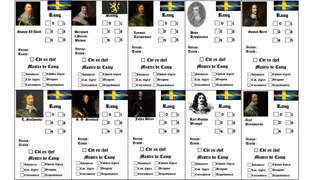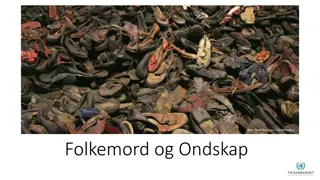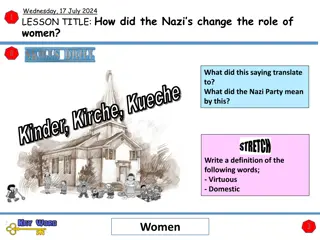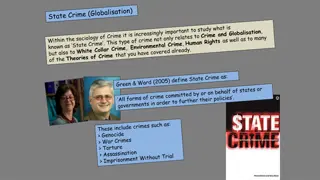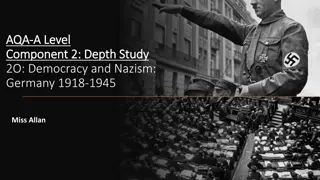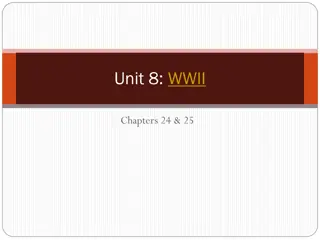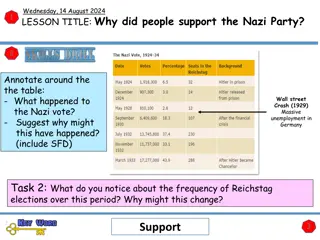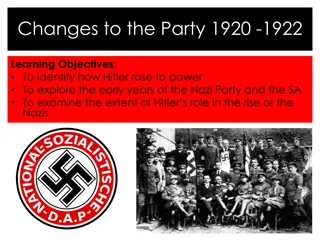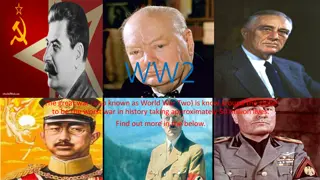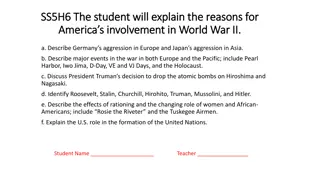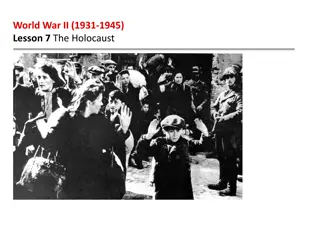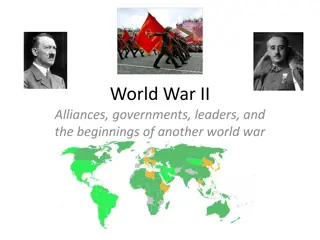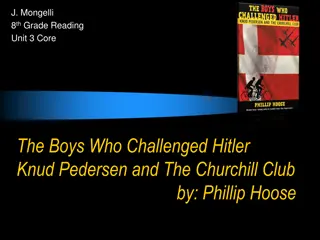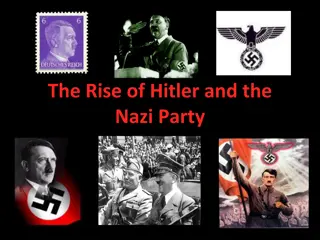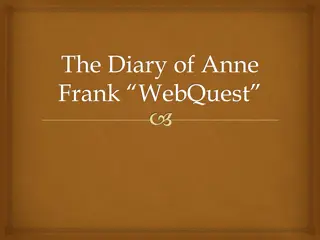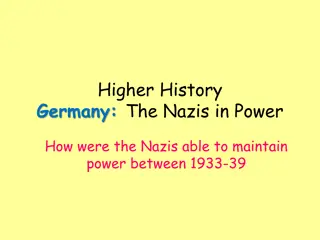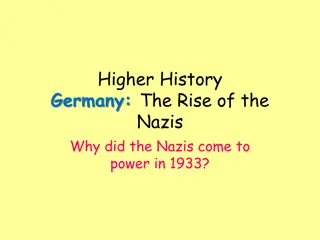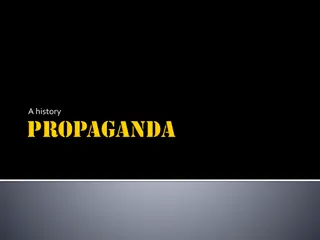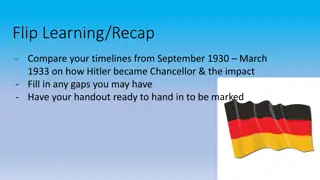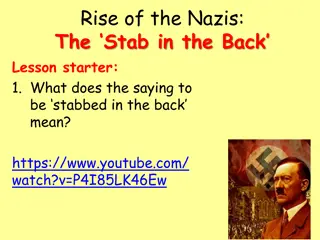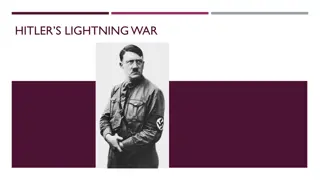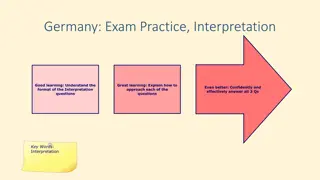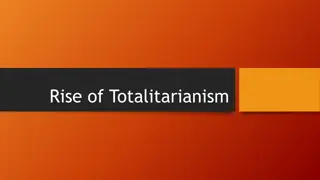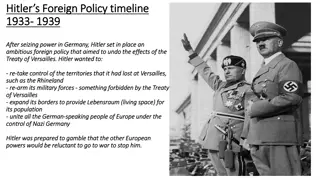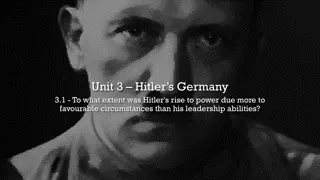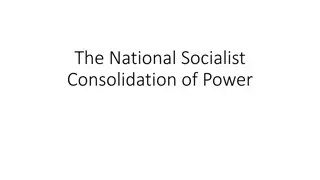Leaders and Commanders Throughout Swedish History
During Swedish history, notable figures such as Gustav II Adolf, Bernhard v. Saxen, Johan B.ner, and others played significant roles as commanders and leaders. From military strategists like Stalhanske to political figures like Axel Oxenstierna, this overview showcases the diverse traits and leaders
1 views • 4 slides
Understanding Genocide: Connection Between Ethnic Cleansing and Evil
Explore the concept of genocide, as defined by the UN, through historical events like the Armenian Genocide and the Holocaust. Delve into the depths of evil and its association with acts of genocide within societies, touching upon the banality of evil and the systematic eradication of entire groups.
2 views • 10 slides
The Transformation of Hitler: From Nobody to Somebody
Explore the events that shaped Adolf Hitler's rise from obscurity to power, including his early life, experiences in World War I, and the societal conditions that influenced his path. Delve into insights from historians like Richard Evans, Ian Kershaw, and William L. Shirer to understand the key tur
0 views • 10 slides
Women's Role in Nazi Germany: Impact and Ideology
Explore how the Nazis shaped the role of women through policies and propaganda, emphasizing domesticity and motherhood. Analyze key figures like Joseph Goebbels and Hitler's perspectives on women's place in society. Understand the contrast between women's lives in Weimar and Nazi Germany.
0 views • 18 slides
The Rise of Hitler: Establishing the Nazi Police State in Germany
This content chronicles the key events leading to Hitler's rise to power in Germany, focusing on the establishment of the Nazi Police State through propaganda, surveillance, and punishment. It discusses Hitler's use of violence, propaganda, and speeches to solidify his control. The effectiveness and
0 views • 9 slides
Collection of Images Featuring Notable Historical Figures
A compilation of images showcasing prominent historical figures such as Pol Pot, Adolf Hitler, and sociologist S. Cohen, including snapshots from various sources like Wikimedia, Google Images, and academic websites. The images are presented in a structured manner with accompanying metadata, possibly
0 views • 10 slides
Understanding Democracy and Nazism in Germany (1918-1945) - A Level History Depth Study
Delve into the complex history of Germany from 1918 to 1945, focusing on the transition from democracy to Nazism. Explore key events like the rise of the Nazi Party, Hitler's dictatorship, and the impact of World War Two. Challenge preconceived notions of good and evil while enhancing your analytica
1 views • 12 slides
World War II in Europe: The Invasion of the USSR and American Involvement
Hitler's plans to invade the USSR starting in 1940, the invasion through the Balkans, Operation Barbarossa in 1941, the challenges faced by German troops, the siege of Leningrad, the US providing aid to its allies, and the Atlantic Charter amid German submarine attacks.
0 views • 7 slides
Hitler's Remilitarization of the Rhineland: Source Analysis and Comparison
Explore the historical context and perspectives on Hitler's remilitarization of the Rhineland in 1936 through a detailed analysis of different sources. Discover the challenges faced by Britain, Hitler's true motives, and contrasting views on his actions from various viewpoints.
0 views • 9 slides
World War II: Events and Strategies
World War II saw significant events unfold, from Hitler's invasions to Japan's attacks on Pearl Harbor, leading to the United States fully engaging in the global conflict. Strategies such as island hopping in the Pacific and the Defeat Hitler First approach in Europe were pivotal in shaping the outc
2 views • 28 slides
Understanding the Rise of Nazi Party Support
The lesson explores why people supported the Nazi Party in Germany during the early 20th century. It examines factors such as the Wall Street Crash of 1929 and the Weimar government's failures, leading to the rise of Adolf Hitler and the Nazi party. Students analyze different interpretations of the
0 views • 9 slides
The Rise of Hitler and the Changes in the Nazi Party 1920-1922
Explore how Adolf Hitler ascended to power and examine the significant developments within the Nazi Party between 1920 and 1922, including Hitler's role, the creation of the SA, the 25 Point Programme, Hitler's leadership, and the use of propaganda and violence.
0 views • 13 slides
Untold Stories of World War II Heroes and Events
Explore remarkable tales from World War II, including the use of Navajo Code Talkers, the bravery of the 761st tank battalion, women's heroism in the Pacific Theater, the strategic alliance between America and Britain, and daring missions like the sabotage of Hitler's atomic bomb project.
0 views • 20 slides
Insights into World War Two and Adolf Hitler's Role
World War Two started on September 3, 1939, with Britain and France declaring war on Germany. Adolf Hitler's rise to power, initiation of the war, and involvement in the Holocaust are highlighted. The Star of David symbolized Jewish identity under Hitler's rule, and the Holocaust saw six million Eur
0 views • 6 slides
World War Two: A Tragic Account of History's Deadliest Conflict
The content provides a glimpse into the horrors of World War Two, detailing key events such as Adolf Hitler's rise to power, the Dunkirk evacuation, the Blitz bombings, and the Soviet Union's pivotal role in pushing back Nazi Germany. It portrays the devastating impact of the war, capturing the loss
0 views • 8 slides
The Rise of Totalitarian Regimes in World War II
In the aftermath of World War I, several European countries fell into economic depression and embraced totalitarian regimes led by leaders like Mussolini in Italy, Stalin in the Soviet Union, Hirohito in Japan, and Hitler in Germany. These leaders wielded total control over their citizens, militariz
0 views • 30 slides
World War II Overview: Causes, Holocaust, and US Involvement
Explore the causes of World War II, including appeasement and the rise of fascism, learn about the devastating Holocaust, and understand the start of the war with Hitler's actions. Delve into the US preparations for war, including the Pearl Harbor attack and internment camps, as it entered the confl
0 views • 7 slides
America's Involvement in World War II: Causes and Impact
In this detailed study guide, students will explore the reasons behind America's involvement in World War II, including Germany and Japan's aggression, major events in Europe and the Pacific, President Truman's decision to drop atomic bombs, key figures like Roosevelt and Hitler, and the effects of
0 views • 13 slides
Understanding the Horrors of the Holocaust in World War II
Explore the dark period of World War II with a focus on the Holocaust, tracing its roots, progression, and impact. Delve into Hitler's campaign against the Jews, his final solution, and the establishment of Nazi death camps. Learn about the devastating consequences of genocide, the United States' re
0 views • 18 slides
The Rise of Dictators and the Beginnings of World War II
The content delves into the events leading up to World War II, highlighting key historical moments such as the rise of dictators like Hitler, Mussolini, and Stalin, along with significant milestones such as the invasion of Poland and the bombing of Pearl Harbor. It emphasizes the ideologies of fasci
0 views • 48 slides
The Boys Who Challenged Hitler: Knud Pedersen and The Churchill Club
The book narrates the inspiring true story of Danish teens who formed the Churchill Club to sabotage the German military during Nazi occupation, sparking a Danish resistance movement. Through acts of courage and defiance, these young patriots played a significant role in their country's fight agains
0 views • 23 slides
Timeline of Key Events Leading to World War II
In the years leading up to World War II, a series of significant events unfolded in Europe. From Hitler's demands and annexations to the signing of pacts and the invasion of Poland, tensions escalated rapidly. The Munich Agreement, German offensive in Poland, declaration of war by France and Britain
0 views • 12 slides
The Rise of Adolf Hitler and the Nazi Party: A Historical Overview
Adolf Hitler, born in Austria in 1889, faced rejection as a painter before turning to politics. He led the National Socialist German Workers Party (Nazi) and orchestrated the failed Beer Hall Putsch in 1923. Imprisoned briefly, he penned Mein Kampf that propagated Nazi ideology. By 1932, the Nazi Pa
0 views • 15 slides
Review of "Diary of Anne Frank" - Final Test Overview
In the final test review of "Diary of Anne Frank," key events are organized in chronological order, vocabulary related to the story is provided, and important themes such as persecution, genocide, and anti-Semitism are highlighted. The content explores the harrowing experiences of Anne Frank and her
0 views • 61 slides
Understanding the Rise and Impact of Nazism in Germany
Explore the factors that led to the rise of Nazism in Germany, including the aftermath of World War I, Hitler's leadership, Mein Kampf, and the Nuremberg Laws. Learn about the devastating Final Solution and why emigration was not a viable option for Jews. Gain insights into the historical events tha
0 views • 15 slides
The Nazis' Consolidation of Power in Germany, 1933-1939
In the period between 1933 and 1939, the Nazis under Hitler orchestrated a series of strategies to maintain power in Germany. This included the establishment of a totalitarian state, implementation of social controls, extensive propaganda campaigns, foreign policy decisions, and economic measures. H
0 views • 38 slides
Understanding the Rise of the Nazis in 1933: Factors and Impacts
Explore the reasons behind the Nazis' ascent to power in 1933, covering political weaknesses of the Weimar government, economic challenges, the appeal of the Nazis, and the lack of unified opposition. Unpack the historical context of post-World War I Germany and the factors that contributed to Hitle
0 views • 38 slides
Weimar and Nazi Germany: A Historical Overview
Germany's tumultuous period from the Weimar Republic to the rise of Hitler's Nazi Party is marked by economic challenges, political unrest, and social transformation. The Weimar Republic faced threats and sought recovery, while Hitler capitalized on the weaknesses of the system to ascend to power in
0 views • 4 slides
The Evolution of Propaganda: From the 1600s to Hitler's Regime
The term "propaganda" originated in the 1600s without a negative connotation until World War I when it became a tool of persuasion and manipulation. Countries utilized propaganda extensively during WWI to sway public opinion. The United States established a propaganda bureau, while Nazi Germany saw
0 views • 32 slides
The Rise of Hitler: From Chancellor to the Night of the Long Knives
Adolf Hitler's journey to becoming Chancellor of Germany involved strategic alliances, internal power struggles, and ultimately the ruthless elimination of his perceived rivals within the SA, culminating in the infamous Night of the Long Knives in June 1934.
0 views • 14 slides
The Stab in the Back Theory: Rise of the Nazis After WWI
The Stab in the Back Theory originated in Germany post-WWI, where people felt betrayed by politicians and generals for surrendering prematurely. Hitler used this theory to blame Socialists, Communists, and Jews, gaining followers by offering someone to blame for Germany's defeat.
0 views • 8 slides
The Rise of Hitler in Germany: Events and Impact
Explore the rise of Hitler in Germany through posters, historical events, and critical questions. Understand how Hitler and the Nazi Party evolved, the significance of the Munich Putsch, reasons for Hitler's chancellorship, and the influence of the Depression and threat of Communism.
0 views • 17 slides
World War II: Hitler's Lightning War and Its Impact
Germany sparked a new war in Europe by signing a nonaggression pact with the Soviet Union and executing a lightning attack on Poland in 1939. Subsequent events, including the fall of France, the Battle of Britain, and developments on the Eastern Front, shaped the course of World War II.
0 views • 10 slides
Interpreting Perspectives on Hitler's Rise to Power in Germany
Explore and compare Interpretations A and B by Albert Speer and Victor Schiff respectively, regarding Hitler's appeal to the German people. Analyze their differing viewpoints based on historical context and personal experiences, providing insights into the complexities of understanding this pivotal
0 views • 14 slides
The Rise of Totalitarianism: Impact of the Great Depression and Hitler's Ascension
Explore the causes of the Great Depression, the impact of the Treaty of Versailles on Italy and Germany, and analyze how Adolf Hitler came to power in Germany amidst the economic turmoil. Dive into the rise of Fascism in Europe, including Nazism, Mein Kampf, and Hitler's strategies for economic reco
0 views • 27 slides
Exploring the Fundamentals of Plant Pathology: Understanding Viruses in Plant Diseases
Delve into the world of plant pathology with Mr. Vikash Kumar, as you learn about the nature, structure, and transmission of viruses affecting plants. Explore the important characteristics of plant viruses, their unique properties, and how they interact within plant cells. Gain insights into viral d
0 views • 14 slides
Hitler's Ambitious Foreign Policy Timeline: 1933-1939
Hitler's foreign policy from 1933 to 1939 aimed at undoing the Treaty of Versailles by reclaiming lost territories, rearming military forces, expanding borders for Lebensraum, and uniting German-speaking people under Nazi Germany. The Saar region's reunification in 1935 boosted Hitler's plans, while
0 views • 12 slides
The Factors Behind Hitler's Rise to Power in Germany
Adolf Hitler's rise to power in Germany was influenced by a combination of favorable circumstances and his leadership abilities. Weaknesses of the Weimar Republic, hyperinflation, and the impact of the Great Depression created a fertile ground for Hitler's ascent. The leadership of Gustav Stresemann
0 views • 17 slides
Connections Between Animal Farm and Historical Figures
Explore the parallels between characters in George Orwell's Animal Farm and real-life historical figures like Adolf Hitler, highlighting how Orwell effectively portrays these connections.
0 views • 5 slides
The National Socialist Consolidation of Power - Legal Revolution in the Reichstag
Hitler's consolidation of power in Germany involved strategic maneuvers such as exploiting the Reichstag fire to pass emergency decrees, suspending civil liberties, and ultimately passing the Enabling Act, granting him dictatorial powers. These actions allowed Hitler to establish a totalitarian regi
0 views • 23 slides
